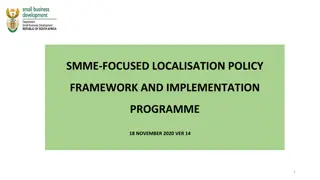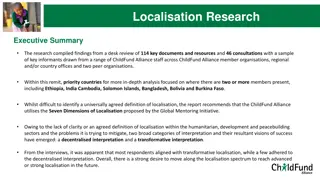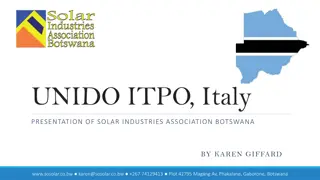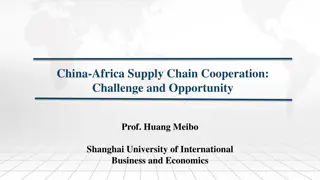Localisation Opportunities in Solar PV Value Chain
Efforts to enhance localisation in the solar PV industry, focusing on achieving competitiveness in quality and price, sustainable local demand, and realistic expectations. Key findings reveal potential for increasing local content in Balance of Plant, Trackers, and Mounting structures.
Download Presentation

Please find below an Image/Link to download the presentation.
The content on the website is provided AS IS for your information and personal use only. It may not be sold, licensed, or shared on other websites without obtaining consent from the author.If you encounter any issues during the download, it is possible that the publisher has removed the file from their server.
You are allowed to download the files provided on this website for personal or commercial use, subject to the condition that they are used lawfully. All files are the property of their respective owners.
The content on the website is provided AS IS for your information and personal use only. It may not be sold, licensed, or shared on other websites without obtaining consent from the author.
E N D
Presentation Transcript
Localisation opportunities in the solar PV value chain Manufacturing Circle Energy Round Table 14 March 2023
Localisation in the solar PV value chain Assumptions and considerations Assessment based almost entirely on 2 key sources of data and information Draft SAREM document published in March 2022 Study on localisation potential of solar PV industry published by SAPVIA in October 2022 Assumption that any local production needs to be competitive (quality and price) in the long term Potential to provide support to infant industry but should be limited in time (max 5 years) Long term sustainability requires ongoing and stable local demand which should be complemented by exports in order to achieve economies of scale and price competitiveness Consideration that the solar PV value chain is still a relatively young industry with fast paced development in both scale and technology Potential window of opportunity to secure strong positioning in the global value chain Need ongoing investment and upgrades to keep up with progress in technology Consideration that expectations must be realistic Local content % in solar PV projects in BW4 (58%) has already achieved a level higher than the average for the automotive sector, which is considered the best example of successful localisation in SA 2
SAREM document Key data and findings ITEM % of CAPEX LC% in BW4 LC% of CAPEX Technology for PV modules is constantly evolving and requires ability to rapidly upgrade facilities; There are currently two local factories for PV modules (ArtSolar and Seraphim) but not competitive against imports so not typically used by private sector; There is some local capacity to produce some components of PV modules (e.g. aluminium frames) but not competitive and it would require some time to ensure proper supply chain integration; Potential for Inverters is mainly in local assembly with limited opportunities for full local production; There is strong potential for Trackers and Mounting structures but some time might be required to ramp up local capacity. BoP 41% 88% 36% PV modules 35% 10% 4% Tracker 11% 85% 9% Inverters 7% 60% 4% Mounting 4% 75% 3% Sundry 2% 100% 2% TOTAL 100% 58% Based on the SAREM data and findings, the most realistic opportunities for localisation in the next 3-5 years seem to be in achieving higher % of local content in BoP, Trackers and Mounting structures 3
SAPVIA study Focus of the study on 9 key components 4
SAPVIA study Local industry status by key component PV module assembling capacity of about 600 MW pa. with old technology and significantly underutilised thus far The two current local module assembling firms have plans to increase their annual assembling capacity to around 2.1 GW, and African Quartz Photovoltaics is also planning to add a further 500 MW Seraphim is also working on establishing a local PV cell production plant with an annual manufacturing capacity of 500 MW PV modules The two local manufacturers currently specialising in microgrid inverter solutions have the capability to produce grid-tied inverters RWW Engineering has been developing grid-tied inverters on a contractual basis for a Spanish OEM, GP Tech Locally produced inverters are much more expensive than Chinese products but on par or cheaper than premium inverters Market is transitioning from centralised inverter solutions to string inverters, which are not locally produced Inverters The local mounting structure and tracker manufacturing industry is relatively developed, with at least 7 manufacturers providing diverse mounting structure solutions with high levels of local content (>90%) Capacity issues need to be addressed for the industry to realise its full potential, including ramping up of manufacturing capacities of local aluminium extruders and meeting warranty and product specification requirements for subcomponents Trackers and mounting structures Copper and/or aluminium can be used for the PV cables but there are currently no local manufacturers of aluminium PV cables Local PV cables have a local content of around 30% since the polymers and the copper are imported Most of the PV cables are imported because of limited local production capacities and the local industry s poor competitiveness in terms of price and quality, particularly with respect to the small flexible PV cables Solar cables The 3 local manufacturers of combiner boxes pay around 20% customs duty to import subcomponents such as PC boards and fuses Allbro is already producing combiner boxes beyond what the local industry can absorb, thus it is also relying on export markets Local manufacturers such as RWW Engineering and Switchgear Unlimited can locally manufacture the switchgear components The local manufacturing industry for controllers is still in a growth phase and can be further developed with the necessary support Charge controllers, solar breakers, combiner boxes and switchgear There are at least 10 local manufacturers of transformers which can ramp up production with a three-month lead time Local transformer manufacturers have relatively small percentages of their transformers targeted at the PV industry The local supply chain for transformers is well established, with copper available locally and the bushings manufactured locally Transformers 5
SAPVIA study Localisation scenarios and key findings Major gaps exist in the local industry s ability to meet the existing and future demand for many components, including solar PV modules, inverters, solar cables, specialised solar transformers, communication panels, uninterruptible power supply (UPS) units, mounting racks (not trackers), switchgear, and circuit breakers and SPDs South Africa s solar PV industry needs sustainable demand of at least 2 GW from the utility segment and fully unlocked residential and C&IAM market segments that in combination with the utility market could deliver at least 3 GW of annual demand Supply chain opportunities exist in ramping up production of aluminium extrusion products and local copper, solar cell manufacturing, solar glass production, and junction box manufacturing 6
Localisation in the solar PV value chain Key take outs Local PV modules are currently not competitive and require big effort and strong sustained demand (including from export) in order to achieve economies of scale feasible? Developments at Seraphim solar cells manufacturing plant should provide further insights on overall feasibility for PV modules and other potential supply chain opportunities Decisions on potential large effort (similar to Chinese approach) to develop PV modules value chain and create African manufacturing hub need to be taken soon to enjoy current window of opportunity for the technology SAPVIA localisation scenarios clearly indicate the best opportunities for moving the needle All pebbles together can only add a very minor increase in local content (0.1%) Mounting racks provide the most apparent opportunity due to local market development and impact (5%) Solar cables also provide opportunities even greater if copper can be sourced locally or local companies start manufacturing aluminum cables Lack of local product certification capabilities adds costs in the value chain same as per other sectors Solar PV industry could join forces with other sector associations to investigate common solutions 7























